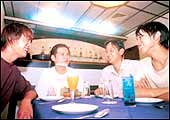|
The
Chinese moon festival dates back to the Tang Dynasty, circa 618
A.D. and celebrates the brightest full moon of the year. Also called
the mid-autumn festival, this takes place on the 15th day of the
eight lunar month, or September 11, 2003, in this case in layspeak.
The celebration this writer attends has the regulation moon cakes,
round pastries filled with black bean. There are also other assorted
pastries, grapefruits, and plastic cups of steaming herbal tea.
Only, all this is happening in Kolkata, in a classroom that has
seen better days at the Chinese School at Tangra, the borough that
houses what remains of the city's once-thriving Chinatown.
"Those were the days this was a real Chinatown,"
sighs Monica Liu, unwrapping a moon cake. Liu's reference is to
a time, in the 1970s, 1980s, even some part of the 1990s when the
narrow Byzantine lanes of Tangra, just off the city's Eastern Metropolitan
Bypass, housed a heaving Chinatown: over 10,000 people, four Chinese
Schools, three newspapers, business interests spanning leather tanneries,
Chinese eating dives with names as predictable as Kim Ling, Canton,
and Beijing, and factories turning out an exotic range of Chinese
pickles and sauces.
Tangra still remains quintessentially Chinese;
most houses are adorned with huge vermillion scrolls emblazoned
with golden script and dangling Chinese lanterns. The buzz, though,
is gone. Of the four schools, only two remain. Of the publications
aimed at the community only one, the Overseas Chinese Commercial
Of India survives.
|

|
|
Gen-next: Dominic Chai (second right) and Jeffrey
Chen (right) with friends on a night out that is increasingly
becoming difficult
|
| Canada
is a popular destination, although the peripatetic Chinese
don't mind moving anywhere in search of better prospects |
Its last rival downed its shutters nearly six
years back. And thanks to a 1996 Supreme Court order, most Tangra
tanneries have been forced to down shutters-they do not meet pollution
control norms-and shift to a straightforwardly titled Leather Complex,
some 20 kilometres away. Rather than do this, most Chinese have
preferred to exit the business altogether. Today, there are less
than 1,000 Chinese left in Tangra. The rest have moved on.
Canada is a popular destination, although the
peripatetic Chinese don't mind moving anywhere in search of better
prospects. Dominic Chai is a 22-year-old who has worked at one of
India's best-known Chinese restaurants, China Garden in Mumbai.
Now he is off to Sweden where he has landed a chef's job. "I
will make five times what I could in India," he says. "Then,
there's the prospect of eventually starting my own restaurant.''
"At least 90 per cent of the young are frantically saving up
for a chance to leave Kolkata," adds Jeffrey Chen, a gawky
21-year-old who manages his family's popular Ka Fu Lok restaurant
and has seen most of his friends and cousins depart for foreign
shores.
|

|
|
"At least 90 per cent of the young Chinese
are frantically saving up for a chance to leave Kolkata"
Jeffrey Chen, Ka Fu Lok
|
| Canada
is a popular destination, although the peripatetic Chinese
don't mind moving anywhere in search of better prospects |
The trend of its young departing for Vancouver,
San Francisco, Sydney, and, more recently, Shanghai should have
spelled good news for the community. After all, the resilience of
the Chinese economy can be attributed, in part, to overseas Chinese
who pump money back into the mainland where they still have family
ties. Unfortunately, the migratory phenomenon in Tangra is different:
the entire family migrates. And the people who remain, often find
themselves a splinter group of families where most of the members
reside in China, Canada, or elsewhere-anywhere but Kolkata.
F.H. Chen is one of those who opted to stay
back. The 47-year-old runs a mid-sized tannery and never felt the
need to join his parents and six siblings in Canada. "Now the
government wants us to give up the place the tannery has been in
for generations and move to a the new Leather Complex," he
rues, pushing back a mop of unruly still-black hair from his forehead.
"It's not easy at all."
The others present at the Moon festival organised
by the Lius-head of family K.C. Liu is President of the Tangra Chinese
Welfare Association and a second generation migrant who runs four
popular Chinese restaurants in Kolkata-are all middle-aged and they
couldn't agree more with Monica Liu's memory of a booming Chinatown.
These are largely die-hard old-timers who cannot bring themselves
to leave Kolkata. Their feeling of alienation and sense of vulnerability
heightened by decreasing numbers, these Tangra residents-many of
them live in houses that are veritable miniature fortresses-strive
to retain their sense of and identity.
|

|
|
There
feeling of alienation heightened by decreasing numbers,
these residents strive to retain their
identity
|
It doesn't help that Kolkata itself is no longer
the city it once was. In Delhi, Mumbai, even Bangalore, Chinatown
would have served as a tourist-magnet. Kau Fu Lok's Chen believes
there's a chance of doing something similar in Kolkata. "There's
no reason why Tangra cannot be marketed like Chinatowns across the
world," he says. His dream is to build a mall in Tangra that
stocks the best Chinese goods. For the moment, however, he is busy
scouting for properties in Bangalore and Hyderabad where he believes
"our distinctive Hakka cuisine will do well".
The moon-worshippers will not be happy to learn
that the spirit of their once-glorious Chinatown will live on in
a noodle shop in Bangalore.
|
TREADMILL
|
| AB infinitum
 That's
right. Even more on building your abs. the quest goes on.
This time, for those who're tired of doing millions of crunches,
here's something that may bring cheer: "Abs aren't made
in the gym, they're made in the kitchen." Every day at
the gym I see people doing hundreds of crunches-weighted crunches,
twisted crunches, side bends, leg raises, the works. The sad
news is that none of that works. None. You can't spot reduce
body fat. Period. Put simply, you can't pick and choose the
areas that you would like to lose fat from and do exercises
to miraculously shed flab from those parts. The body doesn't
work that way. The only way you can cut fat in key areas is
by lowering your total body fat levels. Fat loss happens all
over the body and not from specific areas. That's
right. Even more on building your abs. the quest goes on.
This time, for those who're tired of doing millions of crunches,
here's something that may bring cheer: "Abs aren't made
in the gym, they're made in the kitchen." Every day at
the gym I see people doing hundreds of crunches-weighted crunches,
twisted crunches, side bends, leg raises, the works. The sad
news is that none of that works. None. You can't spot reduce
body fat. Period. Put simply, you can't pick and choose the
areas that you would like to lose fat from and do exercises
to miraculously shed flab from those parts. The body doesn't
work that way. The only way you can cut fat in key areas is
by lowering your total body fat levels. Fat loss happens all
over the body and not from specific areas.
So, how do you develop your abs? Watch what you eat. No
matter how many crunches you do, your abs will not show unless
you lose your body fat. For men, if your body fat falls below
8 per cent (14 per cent for women) that's when the abs begin
to show. Want to calculate your body fat? Here's a site that
will do it for you: www.freeweightloss.com/calculator1.html.
Just enter your weight and waist size and click the button.
This may not be the most scientific method for calculating
body fat since the optimum levels vary depending on the kind
of frame. Calipers that measure the fat layers, especially
around your belly, are better tools. But try out the site
by all means.
Back to the diet. That's step one. Go for a high protein,
moderate carbs and moderate fat diet. Cut out simple sugars,
lower your dairy content and cut out all excess saturated
fats. Most of the fats you consume should come from Omega-6
and Omega-3 fats. Hint: eat fish.
Step two, exercise. Run, walk, jog, or climb at least three
times a week for 30 minutes a session. This speeds fat loss
by increasing your metabolism. Step three, exercise your abs
to tone the muscles. Do them two to three times a week and
stick to simple crunches in the beginning. Don't overwork
your abs. Your abs work like an accordion or a corrugated
board. While doing crunches, therefore, it's not important
how high you raise your trunk, but how tightly you squeeze
your abs. Because that's what maximises your muscle tension
and, hence, develops your ab muscles.
-MUSCLES MANI
|
|
